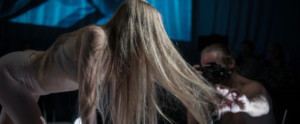Review: I C O N at Grand Théâtre

Last week, the Grand Théâtre of Luxembourg welcomed the show I C O N, an interesting work reflecting on the role of beauty and the desire for recognition in the way we see ourselves and in how the individual reacts to major riddles of existence. The event was advertised as an opera, but if you are looking for an old school Victorian-style performance, you might want to try something else. This was, both in content and format, a 21st century production, with very creative and liberal presentation techniques and focusing on a set of topics that are absolutely crucial for our modern society.
The plot centers around the death of post-death experiences of a beautiful woman who drowns in the Seine (Lieselot de Wilde). Her charm is undeniable and even in death remains a prime concern of her wandering soul. De Wilde delivers almost all of her lines in operatic singing, yet a good part of her performance is focused on her body language, which she uses to display how adrift her character is, and yet how sensually she insists on walking the path of the lost.

Her lines were, however, slightly repetitive and paled in comparison to those of Death (Tibo Vandenborre). The show opens with this personification of Death symbolically taking photos of photos, and delivering a deep and poetic reflection on the topics of the play. Even in its interaction with the deceased woman, there was a visible distinction between the elegance of Death's speech and the replies of this fallen human. Many of Vandenborre's mannerisms and even the emphasis of his rhetoric reminded us of Blade Runner's Roy Batty, which was a surprising connection to establish between these two very distinct stories.
Throughout the play, a band constantly played in the background a music that greatly resembled the tense soundtrack of a silent film, adding to the emotional depth of the play. There were a few moments of interaction with the audience that felt a bit dragged, even for a show where form is as important as content, yet overall we believe it managed to pass its complex and subjective message in a creative and refreshing way.
Image Credit: Kurt Van der Elst
Videos
